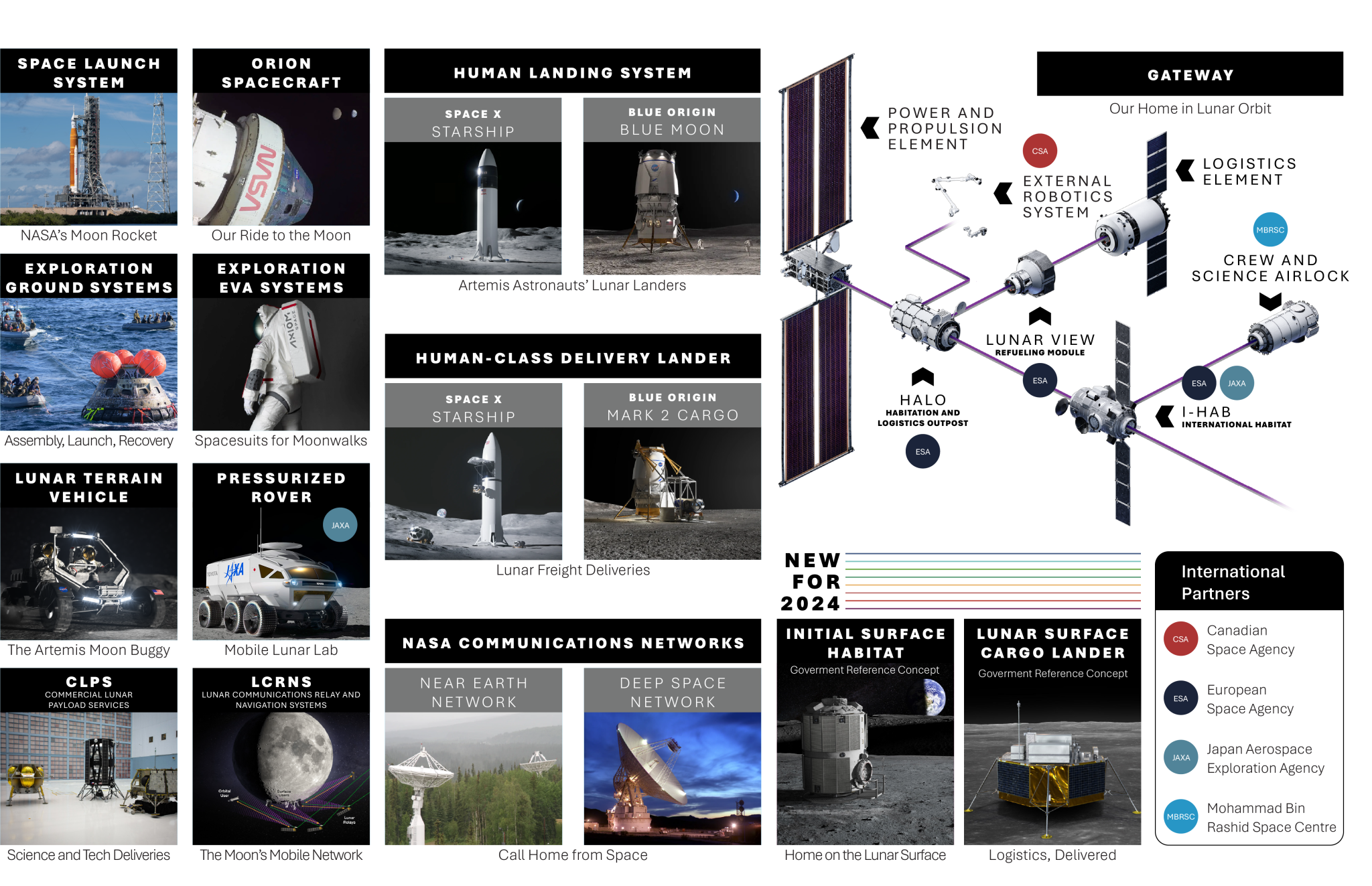Segments
NASA’s Moon to Mars Architecture currently comprises four segments: Human Lunar Return, Foundational Exploration, Sustained Lunar Evolution, and Humans to Mars. These segments capture the evolutionary nature of NASA’s Moon to Mars exploration strategy, growing in complexity over time to meet more of the agency’s Moon to Mars Objectives.
| Human Lunar Return | The Human Lunar Return segment includes the inaugural Artemis missions, which will return humanity to the Moon for the first time since the Apollo missions of the 1960s and 70s. This segment will demonstrate and validate core systems and capabilities for the Moon to Mars effort. This segment will test crew and cargo transportation systems, deploy lunar communications relays, demonstrate technologies, and land the first woman, first person of color, and first international astronaut on the lunar surface. Missions pursued in this segment will lay the groundwork to achieve the Moon to Mars Objectives. |
| Foundational Exploration | The Foundational Exploration segment will prepare for future segments by expanding operations, capabilities, and systems supporting crewed missions to lunar orbit and the Moon’s surface. It will build on initial Human Lunar Return capabilities and validate exploration systems for future Mars missions. Surface missions in this segment will feature increased duration, expanded mobility, and regional exploration of the lunar South Pole. Orbital operations will also increase in duration. The needs of future missions will influence this segment’s activities, which may include reconnaissance, Mars risk reduction, and initial infrastructure for long-term lunar evolution. |
| Sustained Lunar Evolution | The Sustained Lunar Evolution segment aims to build future economic opportunity and greater participation in lunar science and exploration. The segment will increase our science capability, mission duration, and the production of goods and services derived from lunar resources. This segment is an “open canvas,” embracing new ideas, systems, and partners to realize a long-term presence on the Moon and grow the lunar economy. This sustained architecture could achieve existing science objectives and address new science objectives identified through discoveries made in previous segments. |
| Humans to Mars | The Humans to Mars segment will establish a human presence on Mars and empower new science on its surface. Since the earliest days of spaceflight, the Red Planet has captivated humanity. The Moon to Mars Architecture sets a course to finally step foot on a planet beyond humanity’s own. Building on previous segments, this segment will include the initial capabilities and systems necessary to safely travel to Mars, land on its surface, and return safely to Earth. Following this initial journey to Mars, NASA will prepare for progressively longer and more complex missions there. |
Sub-Architectures
Sub-architectures represent a task, technology, or process that NASA must master to achieve the Moon to Mars Objectives. The 12 sub-architectures are listed and described below:
- Autonomous Systems and Robotics employ software and hardware to assist the crew and operate during uncrewed periods.
- Communications and Positioning, Navigation, and Timing Systems enable transmission and reception of data, determination of location and orientation, and acquisition of precise time.
- Data Systems and Management transfer, distribute, receive, validate, secure, decode, format, compile, and process data and commands.
- Habitation Systems ensure the health and performance of astronauts in enclosed environments.
- Human Systems execute human and robotic missions; this includes crew, ground personnel, and supporting systems.
- In-situ Resource Utilization (ISRU) Systems extract resources in space or on the Moon or Mars to generate products.
- Infrastructure Support includes facilities, systems, operations planning and control, equipment, and services needed on Earth, in space, and on planetary surfaces.
- Logistics Systems package, handle, transport, stage, store, track, and transfer items and cargo.
- Mobility Systems move crew and cargo around the lunar and Martian surfaces.
- Power Systems generate, store, condition, and distribute electricity for architectural elements.
- Transportation Systems convey crew and cargo to and from Earth to the Moon and Mars.
- Utilization Systems enable science and technology demonstrations.
Elements
Individual elements in the architecture are the systems and hardware that enable exploration. NASA maps elements to one or more sub-architectures and they may be used across multiple campaign segments.
Some elements predate the architecture development effort (e.g., the Space Launch System and Orion spacecraft) and were mapped to the use cases and functions they already fulfill when this effort began. Other elements have arisen from capability gaps that were not fulfilled by existing elements.
As the Moon to Mars Architecture progresses through the segments, NASA will instantiate more elements to increase the number of Moon to Mars Objectives that missions may accomplish.




























